The
Also see: Example Model: C:\Users\Public\Documents\DCS\3DCS_V5_8_2_0_0\3DCS CAD & Example Models\Reference Models\Measures\Two Point List
|
Input:
| Geometry Requirement | Group 1 : a list of points { Pa1, Pa2, ..., Pan}. |
| Group 2 : a list of points { Pb1, Pb2, ..., Pbm}. |
| Direction Mode | True Distance - This mode may produce incorrect Contributor Analysis or GeoFactor Equation-Based, see Analysis Comparison & Assumptions. |
| Projected along Vector |
| Measure Type | All Points Min |
| Pair Points Min |
| All Points Max |
| Pair Points Max |
Pair Points Max-Min
Center Deviate
•Points Pair (where i=1, 2, ..., n), can be coplanar, but this is not necessary. The same is true for Points Pbj (where j= 1, 2, ..., m).
•For All Points Min and Max, Group A and Group B do not have to have the same number of points, since all combinations are checked.
•For Pair Points Min and Max, Group A and Group B should have the same number of points. Points in Group A should be roughly coordinated with the same index points in Group B. The shorter point list indicates the number of point pairs to be measured, extra points in the longer list will be ignored.
•If the true distance is measured, the value will always be positive.
Output:
1. All Points Minimum
•All Pts Min reports the minimum measurement between the two groups of points. This measurements are made between each point from the first group and every point from the second group.
•The reported value is different if the direction is marked active, or not:
•If the Direction Mode is Projected on Vector, the points in Group 1 are surface points. The reported value is the minimum apparent distance between Group 2 points projected on the vector direction and Group 1 surfaces (5.00 mm in the example below).
•If the Direction Mode is True Distance, the reported value is the minimum true distance between input points (in this case is distance between Pa2 and Pb1).

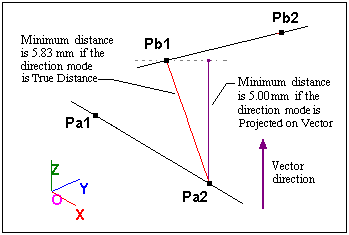
2. Pair Points Minimum
Pair Points Minimum measures pairs of points with the same index from Group 1 and Group 2. The minimum value of the measured pairs is the reported value.
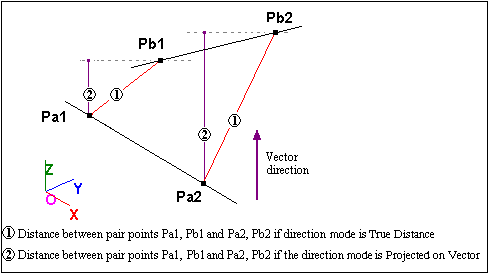
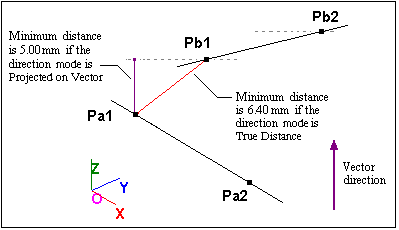
3. All Points Maximum
All Points Maximum performs the same operations as All Points Minimum, except that the largest measurement becomes the reported value.
4. Pair Points Maximum
Pair Points Maximum performs the same operations as Pair Points Minimum, except that the largest measurement becomes the reported value.
5. Pair Points Maximum - Minimum
The Pair Points Maximum - Minimum performs the same operations as Pair Points Minimum and Pair Points Maximum, except it outputs the difference between the two. The computed value is the largest measurement - the smallest measurement.
| 6. Center Deviate |
| Center Deviate allows you to pick consecutive pairs of points and measure where the center plain is. |
Case1: One point in Group1 and one point in Group2.
This will give the variation of a mid point between the two points in the specified direction. A direction must be specified. Projected on Vector must be used.
Value = (((Pt1 + Pt2) / 2) – Nominal Position) * Direction
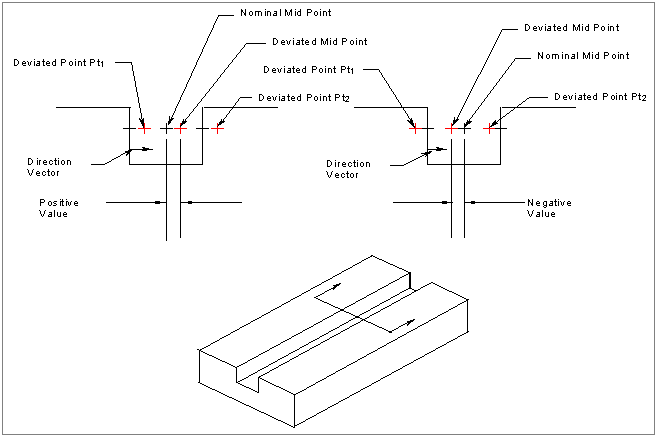
Case2: Two points in Group1 and two points in Group2.
A mid point is calculated between each pair of points. The value is the distance between the mid points in the specified direction. A direction must be specified. Projected on Vector must be used.
Value1 = (((Pt11 + Pt21) / 2) – Nominal Position) * Direction
Value2 = (((Pt12 + Pt22) / 2) – Nominal Position) * Direction
Value = Value1 – Value2
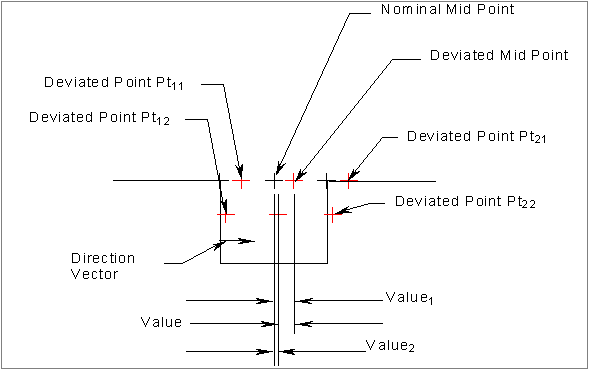
Case3: Three or more points in Group1 and the same number of points in Group2.
A mid point is calculated between each pair of points. The value reported is the absolute value of the greatest distance between the mid points in the specified direction. A direction must be specified. Projected on Vector must be used. The value will always be positive.
Value1 = (((Pt11 + Pt21) / 2) – Nominal Position) * Direction
Value2 = (((Pt12 + Pt22) / 2) – Nominal Position) * Direction …
Valuen = (((Pt1n + Pt2n) / 2) – Nominal Position) * Direction
Value = Maximum Absolute Value of (Value1 – Value2, …Value1 – Valuen, …Valuen-1 – Valuen,)
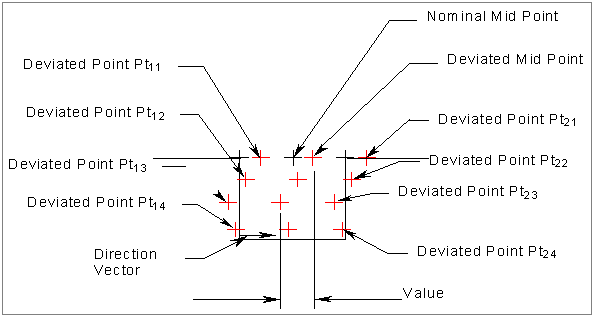
Notes:For best results, users can apply |